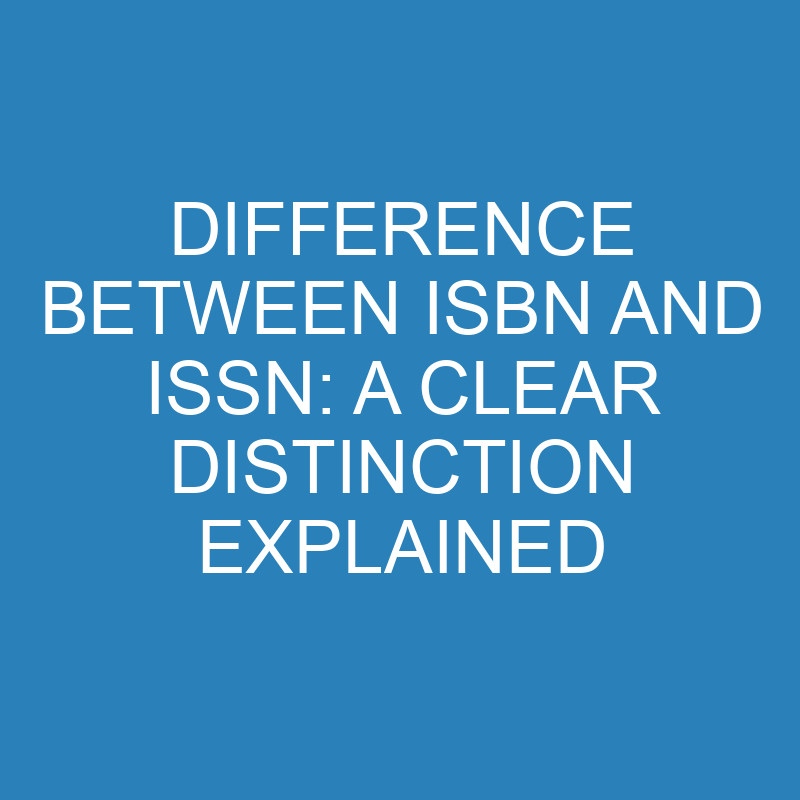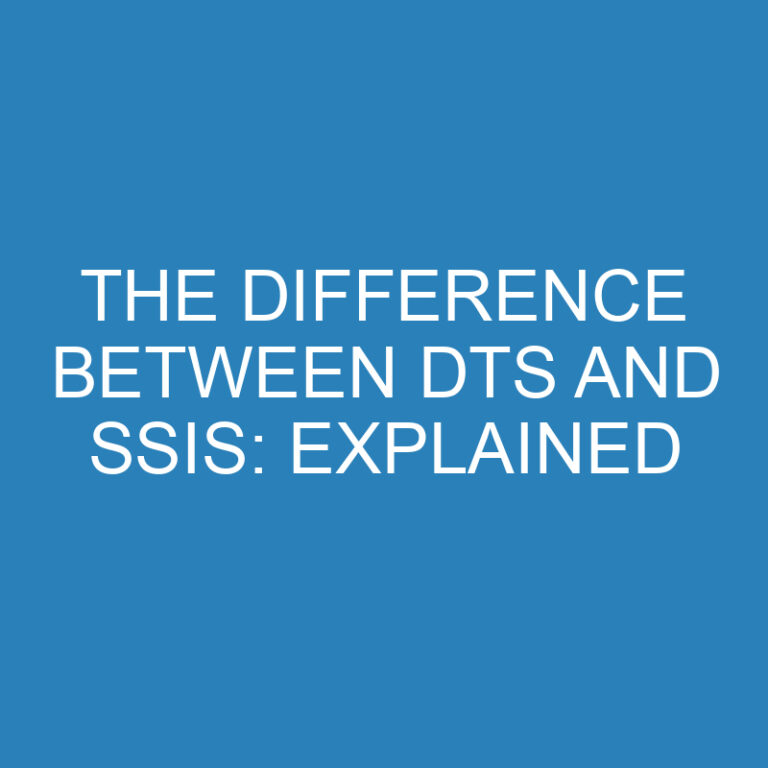
Confused about the difference between ISBN and ISSN? You’re not alone. These two acronyms, although similar in structure, actually refer to distinct identification systems used in the publishing industry. Let me break it down for you.
First off, ISBN stands for International Standard Book Number. It’s a unique numerical identifier assigned to books and other publications to ensure efficient cataloging and tracking. Each edition or format of a book receives its own ISBN, enabling accurate identification across various platforms and helping with sales analysis.
On the other hand, ISSN stands for International Standard Serial Number. This system is specifically designed for periodical publications such as magazines, journals, and newspapers. Similar to an ISBN, an ISSN provides a unique code for each publication variant (print or digital) of a serial publication.
In summary, while both ISBN and ISSN serve the purpose of identifying publications, they are tailored to different types of works. Remember that an ISBN is used for books and related materials, while an ISSN is reserved specifically for periodicals. Understanding these distinctions will help authors, publishers, librarians, and researchers navigate the world of publishing more effectively.
Post Contents
What is an ISBN?
Let’s dive right into understanding what an ISBN is. An ISBN, which stands for International Standard Book Number, is a unique identifier assigned to each edition and variation of a book. It serves as a universal system for identifying books globally, making it easier for publishers, distributors, libraries, and bookstores to manage their inventory.
The ISBN consists of a 13-digit number (previously 10 digits) that encompasses different elements. The first part typically represents the country or language group of the publisher, followed by the publisher identifier and title identifier. The final digit is a check digit used to ensure accuracy and prevent errors when entering or scanning ISBNs.
Why are ISBNs important? Well, they play a crucial role in the book industry. By having an ISBN assigned to your published work, you increase its discoverability and accessibility across various platforms and channels. It enables efficient cataloging of books in libraries and simplifies ordering processes for retailers.
Moreover, having an ISBN allows authors and publishers to track sales data more effectively. This information can be valuable when analyzing market trends or evaluating the success of a particular title. Additionally, some countries offer legal deposit programs that require publishers to provide copies of their publications to national libraries – often facilitated through the use of ISBNs.
In short, an ISBN acts as a unique fingerprint for every book published worldwide. It streamlines communication within the publishing industry while enhancing discoverability and facilitating accurate tracking of sales data.
Remember: Whether you’re an aspiring author or an established publishing professional, understanding what an ISBN is can greatly benefit your journey in the vast world of books!
What is an ISSN?
An ISSN, which stands for International Standard Serial Number, is a unique identifier assigned to serial publications. It serves as a standardized code used to uniquely identify a specific periodical publication, regardless of its medium (print or electronic). The purpose of an ISSN is to provide a reliable and efficient way to track and catalog different publications, making it easier for libraries, publishers, and researchers to locate and reference specific serials.
The format of an ISSN consists of eight digits divided into two groups by a hyphen. The first group typically includes four digits, representing the registration group element that identifies the country or geographic area where the publication was registered. The second group usually contains four digits that represent the individual serial within that registration group.
Here are some key points about ISSNs:
- Uniqueness: Each ISSN is unique to a particular title or edition of a publication. Even if multiple editions exist in different languages or formats (such as print and online), each will have its own distinct ISSN.
- Application: Publishers can apply for an ISSN through their national ISSN center or through designated agencies responsible for assigning ISSNs in their respective countries.
- Benefits: Having an ISSN provides numerous benefits both for publishers and users of serial publications. For publishers, it enhances the visibility and recognition of their work by ensuring accurate identification and facilitating library acquisitions. For users, it simplifies access to desired articles or issues by enabling efficient searching across various databases.
- Coverage: ISSNs are not limited solely to traditional magazines or journals but also include newspapers, newsletters, annual reports, conference proceedings, and other ongoing publications released in successive parts.
- Integration with other systems: ISSNs are often integrated with library cataloging systems such as those using MARC (Machine-Readable Cataloging) records. This integration allows seamless linking between bibliographic data associated with an article or issue and other related information available in libraries’ catalogs.
In conclusion, an ISSN is a unique identifier assigned to serial publications that helps in efficiently tracking and identifying specific periodicals. It simplifies the process of cataloging and locating serials for libraries, publishers, and researchers worldwide.
Purpose of an ISBN
When it comes to the publishing world, an ISBN plays a crucial role in identifying and tracking books. So, what exactly is the purpose of an ISBN? Let’s delve into its significance and how it benefits authors, publishers, and readers alike.
- Unique Identification: The primary purpose of an ISBN (International Standard Book Number) is to provide a unique identifier for each published book. Just like a fingerprint distinguishes individuals, an ISBN sets apart one book from another. This 13-digit code encompasses important information such as country or language group, publisher, and title.
- Efficient Inventory Management: With countless books available in the market, keeping track of inventory can be quite challenging for publishers. Here’s where the power of the ISBN comes into play. By assigning a distinct number to each book edition or format (hardcover, paperback, e-book), publishers can easily manage their stock levels and distribution channels. It facilitates efficient supply chain management throughout the entire publishing industry.
- Enhanced Discoverability: In today’s digital age where information overload is rampant, discoverability is key for authors and their works to stand out from the crowd. An ISBN greatly aids in this aspect by increasing a book’s visibility across various platforms such as online retailers, libraries, databases, and search engines. Readers can quickly find specific editions or formats they desire without confusion or ambiguity.
- Sales Tracking and Royalties: For authors and publishers alike, tracking sales data and calculating royalties accurately are vital aspects of their business operations. An ISBN enables this process by providing valuable sales information through Point-of-Sale (POS) systems or electronic data interchange (EDI). This data helps determine which books are selling well and ensures that authors receive appropriate royalties based on their work’s success.
- Global Recognition: As an international standard used worldwide since 1970s’, the ISBN system allows books to be recognized globally without any language barriers. Whether you’re an author aiming for international reach or a publisher expanding your distribution network, having an ISBN is essential to ensure your book can be easily identified and accessed by readers around the world.
In conclusion, the purpose of an ISBN goes beyond being just a random string of numbers on the back cover of a book. It serves as a powerful tool that aids in identification, inventory management, discoverability, sales tracking, and global recognition. By obtaining an ISBN for their books, authors and publishers can enhance their credibility while ensuring seamless access to their work for readers worldwide.
Purpose of an ISSN
An ISSN, or International Standard Serial Number, serves a specific purpose in the publishing world. It is a unique identifier assigned to serial publications, such as journals, magazines, newspapers, and other recurring publications. The primary function of an ISSN is to provide a standardized way to identify and differentiate these serial publications.
One important purpose of an ISSN is to facilitate efficient and accurate cataloging and indexing of serials. With millions of publications being produced worldwide, having a standardized identification system is crucial for librarians, researchers, and scholars who rely on organized information retrieval. By including the ISSN in bibliographic records and databases, it becomes much easier to locate and access specific articles or issues within a publication.
Moreover, the issuance of an ISSN helps establish the intellectual property rights associated with a serial publication. It acts as proof of ownership for publishers while providing legal protection against unauthorized use or plagiarism. This ensures that authors receive proper recognition for their work and encourages ethical practices within the publishing industry.
Additionally, an ISSN aids in promoting international cooperation among publishers by enabling effective communication across different languages and cultures. With its universal format (ISSN XXXX-XXXX), it transcends language barriers and allows for seamless exchange of information about serial publications on a global scale. This fosters collaboration between publishers from various countries and enhances accessibility to diverse sources of knowledge.
In summary, the purpose of an ISSN goes beyond mere identification; it plays a vital role in facilitating cataloging processes, protecting intellectual property rights, promoting international cooperation among publishers, and ultimately enhancing access to valuable information for researchers worldwide.
Format of an ISBN
The International Standard Book Number (ISBN) is a unique identifier used to distinguish and track books. It plays a crucial role in the publishing industry, facilitating the organization, distribution, and sale of books worldwide. The format of an ISBN consists of several components that provide valuable information about the book.
An ISBN is typically composed of 13 digits or occasionally 10 digits if it was assigned before 2007. Each digit has a specific meaning, making the ISBN more than just a random sequence of numbers. Let’s dive into the structure of an ISBN:
- Prefix Element: The prefix element identifies the language or geographical area to which the publisher belongs. For example, “978” is commonly used for English-language publications.
- Registration Group Element: The registration group element indicates the country or region where the publisher is registered. This element helps in identifying publishers within a specific geographic location.
- Registrant Element: The registrant element identifies the particular publisher or imprint responsible for producing and distributing the book.
- Publication Element: The publication element represents a unique identifier for a specific edition, format, or version of a book published by a particular registrant.
- Check Digit: The check digit serves as an error-detection mechanism within an ISBN number. It ensures data accuracy by verifying that all other digits in the number are entered correctly.
By understanding these components, one can decipher valuable information encoded within an ISBN number itself. This information helps with inventory management, tracking sales figures, and cataloging books accurately across various databases.
It’s important to note that each edition and format variation (such as hardcover, paperback) requires its own distinct ISBN number to differentiate it from others in circulation.
Now that we have examined how an ISBN is structured let’s move on to explore its counterpart – ISSN (International Standard Serial Number).
Format of an ISSN
The International Standard Serial Number (ISSN) is a unique identifier used to distinguish serial publications from one another. It plays a crucial role in the organization and management of journals, magazines, newspapers, and other periodicals. Understanding the format of an ISSN is essential for publishers, librarians, researchers, and anyone involved in the world of serial publications.
An ISSN consists of eight digits divided into two groups: a hyphenated pair separated by a hyphen or space. For example, the ISSN for a particular journal could be written as “1234-5678” or “12345678”. The first seven digits represent the registration group element (RGE), while the eighth digit serves as a check character to ensure accuracy.
To elaborate further on the format, let’s break down each component:
- Registration Group Element (RGE): The first part of an ISSN identifies the country or geographic area where the publication originated. Each country or region has its own unique RGE allocated by the International ISSN Centre. This helps in distinguishing publications from different parts of the world.
- Check Character: The final digit acts as a validation mechanism using a mathematical formula known as modulus 11 calculation. It verifies that all preceding digits are correct and ensures data integrity throughout databases and systems that rely on ISSN identification.
It’s worth noting that when citing an ISSN, it’s preferable to include both hyphens for clarity and consistency with established standards. However, some citation styles may omit them for brevity.
Having a standardized format allows for efficient cataloging, indexing, retrieval, and sharing of information across various platforms worldwide. Whether you’re conducting research or managing serial publications, understanding how an ISSN is structured can greatly facilitate your work.
Remember to bookmark this article so you can easily refer back to it whenever you need clarification on ISBNs versus ISSNs or any related topics we’ve covered so far.
How to Obtain an ISBN
So, you’re ready to get your book out into the world and want to make sure it has all the necessary identification. One essential step is obtaining an ISBN (International Standard Book Number), which serves as a unique identifier for your publication. Here’s a simple guide on how you can go about obtaining an ISBN for your work.
- Identify the official agency: Start by identifying the official agency responsible for assigning ISBNs in your country or region. In the United States, for example, Bowker is the designated agency that handles ISBN assignments.
- Visit the official website: Once you’ve identified the appropriate agency, visit their official website. There, you’ll find all the information and resources needed to obtain an ISBN. Take some time to explore their guidelines and familiarize yourself with their process.
- Register for an account: To proceed with obtaining an ISBN, you’ll likely need to register for an account on the agency’s website. This step ensures that you have access to all relevant forms and services required throughout the application process.
- Provide necessary details: Now it’s time to provide specific details about your publication. This typically includes information such as title, author name(s), format (eBook, paperback, hardcover), edition number (if applicable), language, and publication date.
- Pay any applicable fees: Depending on your location and circumstances, there may be associated fees with acquiring an ISBN. Ensure that you review and understand any costs involved in order to complete payment during this stage of the process.
- Receive your assigned ISBN: After submitting your application and completing payment (if required), you will receive your assigned ISBN from the agency via email or through their designated communication channel.
- Assigning individual identifiers: Once you have obtained your initial ISSN, you can proceed to assign individual identifiers to each particular version or format of your publication. This ensures that every edition has a unique identifier attached to it.
- Update your book: Finally, make sure to update your book’s cover, copyright page, and any online listings with the assigned ISBN(s). This step is crucial for proper identification and tracking of your publication in the industry.
Remember, obtaining an ISBN is an important step in making your work discoverable and easily identifiable by booksellers, libraries, and readers worldwide. Follow these steps carefully to ensure a smooth process from application to assignment.
Sure, I’ll make sure to follow the guidelines and write in English (US) language. Here’s the section on how to obtain an ISSN:
How to Obtain an ISSN
If you’re looking to obtain an ISSN (International Standard Serial Number), there are a few steps you need to follow. The ISSN is a unique identifier used for periodical publications such as magazines, journals, newspapers, and even online publications. Here’s what you need to do:
- Determine your eligibility: First and foremost, ensure that your publication meets the criteria for obtaining an ISSN. Generally, serial publications with regular publication intervals qualify for an ISSN. This includes both print and electronic formats.
- Contact the National ISSN Center: Each country has its own National ISSN Center responsible for issuing ISSNs. Find your country’s center and get in touch with them. They will guide you through the application process and provide any necessary forms or documentation required.
- Complete the application: Fill out the application form provided by the National ISSN Center accurately and thoroughly. Include all relevant information about your publication such as title, frequency of publication, format (print or online), language(s) used, publisher details, etc.
- Submit supporting documents: Along with your application form, you may be required to submit additional supporting documents such as sample issues of your publication or proof of legal deposit depending on your country’s requirements.
- Pay any applicable fees: Some countries charge a fee for processing ISSNs while others offer it free of charge. Check with your National ISSN Center regarding any fees involved and make sure to pay them accordingly.
- Wait for processing: After submitting your application along with all necessary documents and fees, patiently await the processing of your request by the National ISSN Center. The time taken for approval can vary depending on their workload.
- Receive your assigned ISSN: Once approved, you will receive your assigned ISSN. This unique identification number will be associated with your publication and can be used for cataloging, archiving, and other purposes.
Remember, the ISSN is specific to each individual title of a serial publication. If you have multiple titles or editions within the same series, you may need separate ISSNs for each one.
By following these steps and working closely with your National ISSN Center, you’ll be well on your way to obtaining an ISSN for your publication. Good luck!
Differences between ISBN and ISSN
Regarding publishing, a few key identifiers help keep things organized and easily searchable. These important identifiers are ISBN (International Standard Book Number) and ISSN (International Standard Serial Number). While they may seem similar at first glance, the two have some distinct differences.
- Purpose:
- ISBN: An ISBN’s primary purpose is to uniquely identify books and other monographic publications. It helps in tracking sales, inventory management, and library cataloging. Each edition or format of a book receives a unique ISBN.
- ISSN: On the other hand, an ISSN is specifically assigned to serial publications such as newspapers, magazines, journals, annuals, and even electronic publications. Its main function is to provide a standardized way of identifying ongoing titles that have regular updates or releases.
- Structure:
- ISBN: An ISBN consists of 13 digits divided into five parts – prefix element (978 or 979), registration group element (identifies the country/region/language group), registrant element (identifies the publisher), publication element (identifies specific title/format), and check digit.
- ISSN: In contrast, an ISSN comprises eight digits divided by a hyphen into two groups of four digits each. The first group represents the media type or medium identifier while the second group identifies the specific title within that media type.
- Application:
- ISBN: Publishers use an ISBN to make their books discoverable in databases, online marketplaces, libraries, and bookstores worldwide. It aids in efficient ordering processes for retailers as well as simplifies cataloging efforts for libraries.
- ISSN: Serial publishers utilize an ISSN to establish their credibility within academic circles and facilitate subscriptions for libraries and institutions that rely on regular access to these publications.
- Flexibility:
- ISBN: Since each edition or format variation requires its own unique identifier, an ISBN allows publishers to distinguish between hardcovers, paperbacks, e-books, and other versions of the same title.
- ISSN: On the other hand, an ISSN stays constant for a specific serial publication even if there are changes in format or medium. This ensures that readers can easily identify and locate their preferred titles amid any modifications.
Understanding the differences between ISBN and ISSN is essential for publishers, librarians, researchers, and book enthusiasts alike. While both identifiers play crucial roles in organizing and identifying publications, they serve distinct purposes within the publishing world. So whether you’re writing a book or subscribing to your favorite magazine, knowing which identifier applies will help ensure efficient dissemination of information.
Conclusion:
In conclusion, the key difference between ISBN and ISSN is their purpose and application. While both are unique identifiers for publications, they serve distinct functions in the world of literature and scholarly works.
- Purpose:
- Application:
- Format:
- Usage:
In summary, while ISBNs help identify unique editions of books, ISSN is used to distinguish ongoing periodical publications. Understanding the differences between these two identifiers can assist authors, publishers, libraries, and readers in efficiently navigating the vast world of literature and scholarly works.






